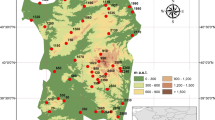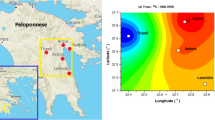Abstract
Trends and periodicity analyses can provide information on climate variability inherent in a particular variable. In this study, trend tests and spectral analysis are used to examine the existence of trends and cycles in temperature series (1901–2000) of Nigeria. Periods 1901–1929 and 1942–1980 exhibited cooling trends while 1930–1941 and 1981–2000 showed warming trends. The warmest years in Nigeria were 1941, 1935, 1931 and 1987. The coldest years were 1929, 1975, 1925 and 1974. Whereas no significant trends were detected for 1901–1930 period, the standard period 1931–1960 was marked by significant cooling while 1961–1990 was marked with significant warming. Annual temperature has risen by 0.03 °C/decade during the last century. The overall warming was mostly confined to the south of 12°N especially during April and June. Changes in minimum temperature are higher than that of maximum temperature. The quasi-biennial oscillation was found in annual data for all the six zones with periods of about 2–4 years. Nigeria landscape is under strong North Atlantic Oscillation influence in dry season and under ENSO influence during wet season. Annual temperature series was also found to exhibit significant negative correlation with SOI.






Similar content being viewed by others
References
Adefolalu DO, Pam JL, Habbi HM (2007) Climate change and safety of air transportation—a Nigerian perspective. In: Proceedings of the international conference on the impacts of extreme weather and climate on socio-economic development in Africa held at the Federal University of Technology, Akure, Nigeria, 11–15 Nov 2007, pp 1–15
Balogun IA, Ajayi VO, Ogunjobi KO (2009) Influence of urbanization on the temperature of Abuja and its environs. J Meteorol Climate Sci 7:46–54
Box JE (2002) Survey of Greenland and instrumental temperature records: 1873–2001. Int J Climatol 22:1829–1847
Chang-Seng SD (2007) Climate variability and climate change assessment for the Seychelles, Second National Communication (SNC), under the United Nations Framework Convention on Climate Change (UNFCCC). Ministry of Environments and Natural Resources, Republic of Seychelles
Chindo A, Nyelong PN (2005) Lake Chad: from Megalake to Minilake. Arid Wetland Bull 6:24–27
Clerk CR (2002) Climate change or climate fluctuation? J Arid Environ 1(1):18–33
Dang H, Gillett NP, Weaver AJ, Zwiers FW (2007) Climate change detection over different land surface vegetation classes. Int J Climatol 27:211–220
Domroes M, El-Tantawi A (2005) Recent temporal and spatial temperature changes in Egypt. Int J Climatol 25:51–63
Easterling DR (1997) Maximum and minimum temperature trends for the global. Science 277:364–367
Fan Z, Brauning A, Thomas A, Li J, Cao K (2010) Spatial and temporal temperature trends on the Yunnan Plateau (Southwest China) during 1961–2004. Int J Climatol. doi:10.1002/joc.2214
Fujibe F (1995) Temperature rising trends at Japanese cities during the last one hundred years and their relationships with population increasing rates and daily temperature ranges. Pap Meteorol Geophys 46:35–55
Hasanean HM (2001) Fluctuations of surface air temperature in the east Mediterranean. Theoret Appl Climatol 68(1–2):75–87
Hess TM (1998) Trends in reference evapotranspiration in North East arid zone of Nigeria 1981–91. J Arid Environ 38:99–115
Hu ZZ, Yang S, Wu R (2003) Long-term climate variations in China and global warming signals. J Geophys Res 108:4614
Hulme M, Doherty R, Ngara T, New M, Lister D (2001) African climate change: 1900–2100. Clim Res 17:145–168
Ikhile CI (2007) Impacts of climate variability and change on the hydrology and water resources of the Benin-Owena River Basin. PhD Thesis submitted to the Department of Geography and Regional Planning, University of Benin, Benin City, Nigeria
IPCC (2001) Climate Change 2001 Synthesis Report. Cambridge University Press, Cambridge, p 397
IPCC (2007) Climate change: impacts, adaptation and vulnerability. In: Parry M, Canziani O, Palutikof J, van der Linden P, Hanson C (eds) Contribution of Working Group II to the Fourth Assessment Report of the Intergovernmental Panel on Climate Change, Cambridge University Press, Cambridge
Karl TR, Janes PD, Knight RW, Kukla J, Plummer N, Razuvayev V, Gallo KP, Lindesay J, Charlson RJ, Peterson TC (1993) A symmetric trends of daily maximum and minimum temperatures: empirical evidence and possible causes. Bull Am Math Soc 74:1007–1023
Kiely G (1999) Climate change in Ireland from precipitation and streamflow observations. Adv Water Resour 23:141–151
Lamb HH (1972) Climate: present, past and future fundamentals and climate now, vol 1. Methuen and Co. Ltd, London
Liu XD, Yin ZY, Shao XM, Qin NS (2006) Temporal trends and variability of daily maximum and minimum, extreme temperature events, and growing season length over the eastern and central Tibetan Plateau during 1961–2003. J Geophys Res Atmos 111:D19109. doi:10.1029/2005JD006915
Lu N, Wilske B, Ni J, John R, Chen J (2009) Climate change in Inner Mongolia from 1955 to 2005—trends at regional, biome and local scales. Environ Res Lett 4:045006. doi:10.1088/1748-9326/4/4/045006
Meissner K, Weaver A, Matthews H, Cox P (2003) The role of land surface dynamics in glacial inception: a study with the UVic earth system model. Clim Dyn 21:515–537
Mitchel TD, Hulme M, New M (2001) Climate data for political areas. Observations 109–112
Mitchell TD, Jones PD (2005) An improved method of constructing a database of monthly climate observations and associated high-resolution grids. Int J Climatol 25:693–712
Nasrallah HA, Nieplova E, Ramadan E (2004) Warm season extreme temperature events in Kuwait. J Arid Environ 56:357–371
New M, Hulme M, Jones PD (1999) Representing twentieth century space-time climate variability. Part I: development of a 1961–90 mean monthly terrestrial climatology. J Clim 12:829–856
Nwafor JC (2006) Environmental impact assessment for sustainable development: the Nigerian perspective. Environmental and development policy centre for Africa, Enugu, pp 372–385
Odjugo AO (2010) Regional evidence of climate change in Nigeria. J Geogr Reg Plan 3(6):142–150
Odjugo AO, Ikhuoria AI (2003) The impact of climate change and anthropogenic factors on desertification in the semi-arid region of Nigeria. Glob J Environ Sci 2(2):118–126
Oguntunde PG, Friesen J, van de Giesen N, Savenije HHG (2006) Hydroclimatology of the Volta River Basin in West Africa: trends and variability from 1901 to 2002. Phys Chem Earth 31:1180–1188
Oguntunde PG, Abiodun BJ, Lischeid G (2011) Rainfall trends in Nigeria, 1901–2000. J Hydrol 411:207–218
Phillips CL, Parr JM, Riskin EA (2008) Signals, systems and transforms, 4th edn. Prentice Hall, New Jersey
Reed RJ, Campbell WJ, Rasmussen LA, Rogers RG (1961) Evidence of downward propagating annual wind reversal in the equatorial stratosphere. J Geophys Res 66:813–818
Rehman S (2010) Temperature and rainfall variation over Dhahran, Saudi Arabia, (1970–2006). Int J Climatol 30:445–449
Salmi T, Maatta A, Anttila P, Ruoho-Airola T, Amnell T (2002) Detecting trends of annual values of atmospheric pollutants by the Mann-Kendall test and Sen’s slope estimates. Publications on air quality, No 31. Helsinki, Finland
Singer SF, Avery DT (2007) Unstoppable global warming: every 1000 years. Rowman and Littlefield Publishers Inc, New York
Snyder PK, Delire C, Foley JA (2004) Evaluating the influence of different vegetation biomes on the global climate. Clim Dyn 23:279–302
Tabari H, Hosseinzadeh Talaee P (2011) Recent trends of mean, maximum and minimum air temperatures in the western half of Iran. Meteor Atmos Phys 111:121–131
Tosic I, Unkasevic M (2005) Analysis of rainfall series for Belgrade. Theor Appl Climatol 80(1):67–77
Turkes M, Sumer UM, Demir I (2002) Re-evaluation of trends and changes in mean, maximum and minimum temperatures of Turkey for the period 1929–1999. Int J Climatol 22:947–977
Zhai P, Sun A, Ren F, Liu X, Gao B, Zhang Q (1999) Changes of climate extremes in China. Clim Change 42:203–218
Zhang R, Delworth TL (2006) Impact of Atlantic multidecadal oscillations on India/Sahel rainfall and Atlantic hurricanes. Geophys Res Lett 33:L17712. doi:10.1029/2006GL026267
Acknowledgments
The first author gratefully acknowledges the support of the Alexander von Humboldt Foundation, Bonn, Germany. The second author was partly supported by National Research Foundation (NRF, South Africa) and the International Science Program (ISP, Sweden).
Author information
Authors and Affiliations
Corresponding author
Additional information
Responsible editor: B. Ahrens.
Rights and permissions
About this article
Cite this article
Oguntunde, P.G., Abiodun, B.J. & Lischeid, G. Spatial and temporal temperature trends in Nigeria, 1901–2000. Meteorol Atmos Phys 118, 95–105 (2012). https://doi.org/10.1007/s00703-012-0199-3
Received:
Accepted:
Published:
Issue Date:
DOI: https://doi.org/10.1007/s00703-012-0199-3




